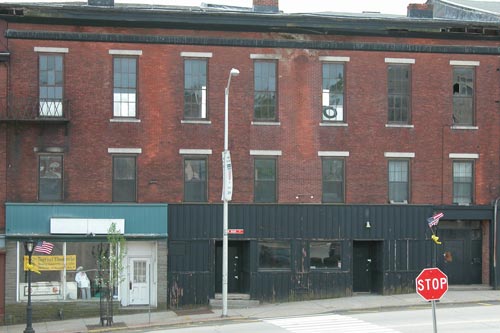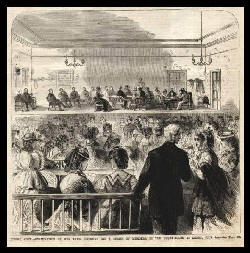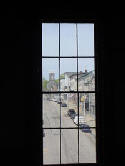Derby History QuizCurrent Quiz Archives of all quizzes
It's future looks bleak as the picture above attests. We also want to thank Rick Dunne, Randy Ritter and Joan Driscoll who went above and beyond the call of duty by actually going into the armory to see what it looks like today. Unfortunately, it doesn't look much better inside than it does outside. The site is now currently part of the city's plan for redevelopment, and it's unlikely that the structure will survive. (The building was torn down in 2006!)
The building went up on the south side of Main Street sometime in the late 1840's. The building was erected by David Nathan an emigrant from Wales. According to noted Derby historian Albert Sherwood, David and his brother Isaac came to Derby to work in Anson Phelps' copper factories. Though without an education, they had experience in the copper industry in Wales. Isaac used the money he compiled to go into the hoopskirt business before moving on to St. Louis when the hoopskirt business went out of style. David took to real estate as an investment and constructed the building above. Some thought the steep slope of the land made the lot commercially unviable, but David erected a building that has three visible stories on Main Street, but is actually six stories high if you go around to the back. The bottom three stories served as tenement housing for many of the factory workers of the area. The first floor on the Main street side (fourth floor overall) was designed for stores and the second floor for offices. The top floor (sixth floor) was a large auditorium and was much needed at the time. Prior to the erection of the building, most large functions were held in the basements of area churches. "Nathan's Hall" became the Mecca of community activity. Its stage supported both local entertainers and road shows including an annual performance of Uncle Tom's Cabin. Great orators of the time including Henry Ward Beecher, George William Curtis, and Wendell Phillips boomed out scholarly lectures and at least one future president, James A. Garfield, also spoke here and both political parties held party rallies there and the Connecticut Socialist Party had its office there. Perhaps the building brought the most joy to the locals when it was the site of many dances and balls. In writing about this, noted Derby historian Albert Sherwood said:
The Hotchkiss, Storms and Paugassetts held their annual concerts and balls in the hall. Not only did the building serve as a court, but it also served as the center of government for the Borough of Birmingham until the new city hall (Sterling Opera House) was built. It had a jail on one of the lower floors and the chief of police had an office upstairs. It also served as a polling site for local elections. The auditorium was also the first home of the Derby High School basketball program with games being played there starting in 1910. Boxing and wrestling exhibitions were also held there. David Nathan died in 1880 and is buried in Oak Cliff cemetery. Some time after his death the name of the building was changed to Gould Armory and it continued to serve as a dance hall until the last dance was held in 1933. Today, it's future is uncertain as redevelopment seems poised to impose the wrecker's ball to a structure that played an enormous role in the history of the city and brought great pleasure to its inhabitants. Correct answers were received from: Rick Dunne, Randy Ritter, Joan Driscoll, Andrew DeTullio, Millie from Ansonia, and Mayor Marc J. Garofalo. To see our other earlier quizzes and learn more about Derby's unique history, click here.
|
|||||||||||

 This quiz proved to be the most difficult since the Derby History quiz
was first launched. The picture on the left showing Lydia Sherman's trial as
a serial killer wasn't enough to keep people from guessing a far more famous
building in Derby (The subject of another quiz!). However, Gould's armory
has quite a history of its own as you will see by reading on.
This quiz proved to be the most difficult since the Derby History quiz
was first launched. The picture on the left showing Lydia Sherman's trial as
a serial killer wasn't enough to keep people from guessing a far more famous
building in Derby (The subject of another quiz!). However, Gould's armory
has quite a history of its own as you will see by reading on. 



